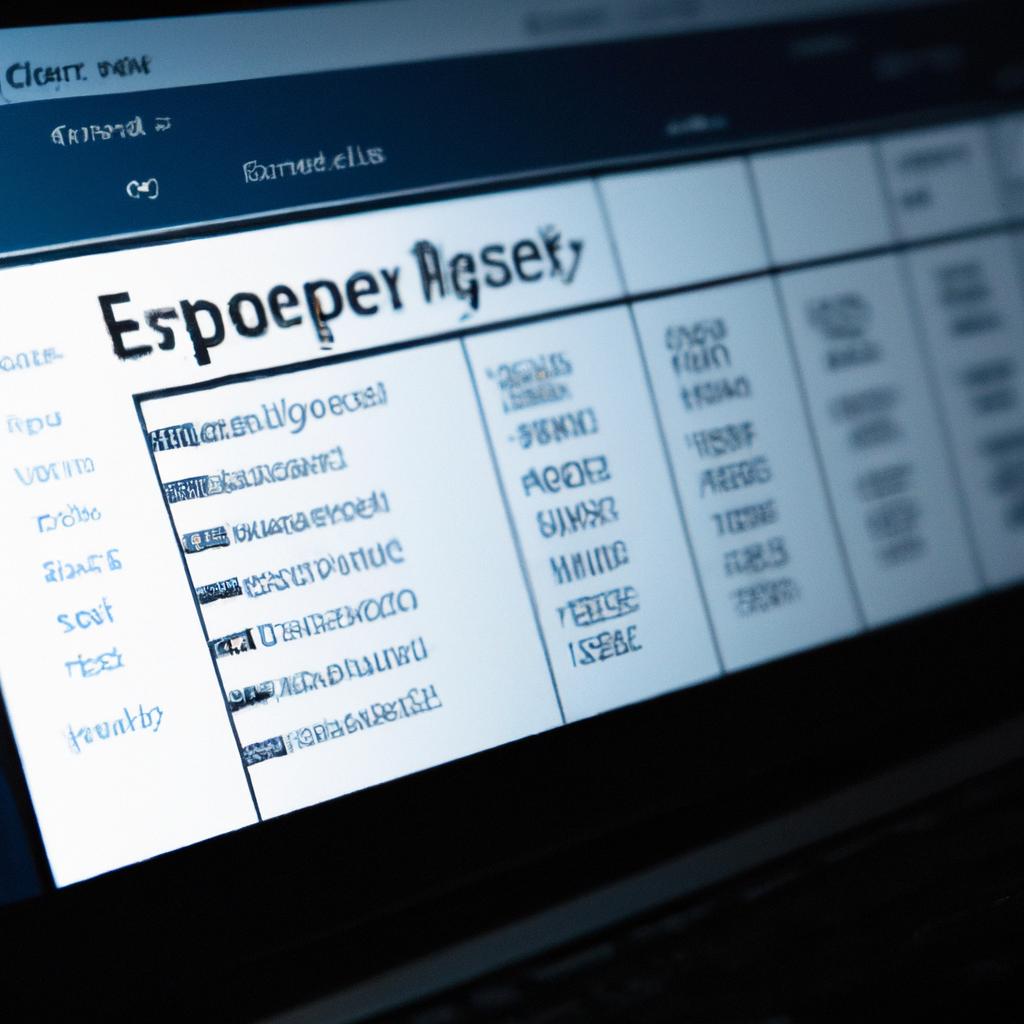Introduction

In today’s fast-paced business landscape, staying ahead of the competition is crucial. To achieve this, businesses rely heavily on efficient systems that can seamlessly integrate and manage various aspects of their operations. Enter ERP software – the backbone of modern enterprises. But what exactly is ERP software, and why is it so important?
A. Definition of ERP software
ERP stands for Enterprise Resource Planning, a comprehensive software solution designed to streamline and automate core business activities. From inventory management and customer relationship management to finance and human resources, ERP software enables organizations to consolidate their data and processes into a centralized system, enhancing productivity and efficiency.
B. Importance of ERP software in businesses
Implementing the right ERP software can be a game-changer for businesses of all sizes. By providing a holistic view of operations, ERP software allows organizations to make data-driven decisions, optimize resource allocation, and improve overall productivity. It eliminates the need for disparate systems and manual data entry, reducing errors and saving valuable time. ERP software also enables seamless collaboration across departments, fostering better communication and alignment within the organization.
C. Overview of popular ERP software options
When it comes to choosing the right ERP software for your business, the market offers a wide range of options. Some of the most popular erp software solutions include renowned names like Oracle NetSuite, SAP ERP, and Microsoft Dynamics 365. These industry-leading systems offer robust features, scalability, and customization options to meet the diverse needs of businesses across various sectors.
In the next sections, we will delve deeper into the features of popular ERP software, compare the top solutions, discuss factors to consider when selecting ERP software, and explore the implementation and adoption processes. So, buckle up and let’s embark on a journey to discover the power of popular ERP software solutions!
Stay tuned for Section II where we explore the powerful features of popular ERP software that can transform your business operations.
Features of Popular ERP Software
When it comes to selecting the right ERP software for your business, understanding the key features is essential. Let’s explore the standout features that make popular ERP software solutions indispensable for efficient business operations.
A. Module integration and customization
One of the significant advantages of popular ERP software is its ability to integrate various modules seamlessly. Whether it’s inventory management, supply chain, finance, or human resources, ERP software consolidates all these functions into a unified system. This integration enables real-time data sharing across departments, eliminating silos and fostering collaboration. Additionally, popular ERP software solutions offer customization options, allowing businesses to tailor the software to their unique requirements.
B. Scalability and flexibility
Businesses are dynamic entities, and their needs evolve over time. Popular ERP software solutions are designed to scale with your organization’s growth. They offer flexible configurations and customizable workflows that adapt to changing business requirements. With the ability to add or modify modules and functionalities, popular ERP software ensures that your system remains agile and future-proof.
C. Real-time data tracking and reporting
In today’s data-driven world, having access to real-time information is crucial. Popular ERP software provides businesses with the ability to track and analyze data in real-time. This allows for better decision-making, as managers can monitor key metrics, identify trends, and make strategic adjustments promptly. Furthermore, comprehensive reporting features enable the generation of accurate and insightful reports, empowering businesses to gain valuable insights into their operations.
D. User-friendly interface and navigation
ERP software can be complex, given its extensive functionalities. However, popular ERP software solutions prioritize user experience and offer intuitive interfaces that make navigation a breeze. With user-friendly dashboards, simplified workflows, and easy-to-use features, these systems ensure that employees can quickly adapt to the software and maximize its capabilities.
E. Integration with other business systems
To achieve a seamless flow of information across your entire organization, integration with other business systems is crucial. Popular ERP software solutions provide integration capabilities with third-party applications such as CRM systems, e-commerce platforms, and project management tools. This integration allows for efficient data exchange, enhances productivity, and eliminates redundant manual processes.
Stay tuned for Section III where we compare and analyze the top ERP software solutions in the market and help you make an informed decision.
Section III: Comparison of Top ERP Software Solutions
In the vast landscape of ERP software solutions, it’s essential to understand the unique offerings and capabilities of each option. Let’s dive into a comparison of the top ERP software solutions – ERP Software A, ERP Software B, and ERP Software C – to help you make an informed decision for your business.
A. ERP Software A
1. Key features and advantages
ERP Software A boasts a robust set of features that can revolutionize your business operations. With seamless module integration and customization options, this software allows you to tailor the system to your specific needs. Its scalability and flexibility ensure that your ERP solution grows with your business, adapting to changing requirements effortlessly. Real-time data tracking and reporting provide valuable insights for informed decision-making, while the user-friendly interface and navigation make it easy for your team to adopt and utilize the software effectively. Moreover, ERP Software A seamlessly integrates with other business systems, eliminating data silos and enhancing cross-functional collaboration.
2. Pricing plans and options
Pricing is a crucial factor when considering an ERP software solution. ERP Software A offers flexible pricing plans tailored to accommodate businesses of different sizes and needs. From subscription-based models to one-time licensing fees, you can choose a pricing structure that aligns with your budget and financial goals. Additionally, ERP Software A provides transparent pricing options, ensuring you have a clear understanding of the costs involved.
3. Customer reviews and ratings
Customer reviews and ratings offer valuable insights into the performance and satisfaction levels of ERP Software A users. With an average rating of 4.5 stars, this software has garnered positive feedback for its comprehensive features, ease of use, and reliable customer support. Customers praise its ability to streamline operations, improve efficiency, and enhance overall productivity.
B. ERP Software B
1. Key features and advantages
ERP Software B stands out with its unique features and advantages. With a strong focus on customization, this software allows businesses to tailor their ERP solution to their specific industry requirements. Its advanced analytics and reporting capabilities provide valuable insights for data-driven decision-making. Additionally, ERP Software B offers seamless integration with third-party applications, making it a versatile choice for businesses with existing systems.
2. Pricing plans and options
When it comes to pricing, ERP Software B offers flexible options to suit different business needs. From affordable subscription plans to enterprise-level pricing structures, you can find a package that fits your budget. The transparent pricing model ensures you have a clear understanding of the costs and any additional fees involved.
3. Customer reviews and ratings
Customers have praised ERP Software B for its industry-specific features, robust customization options, and reliable performance. With an average rating of 4.7 stars, users appreciate its ability to streamline processes, enhance collaboration, and drive overall efficiency.
C. ERP Software C
1. Key features and advantages
ERP Software C brings a unique set of features and advantages to the table. With its user-friendly interface and intuitive navigation, it ensures a seamless user experience. The software offers comprehensive modules for various business functions, including finance, inventory, and CRM. Its powerful integration capabilities enable smooth data flow between systems, optimizing workflows and enhancing productivity.
2. Pricing plans and options
ERP Software C provides flexible pricing plans to accommodate businesses of different sizes and budgets. From tiered subscription models to customizable packages, you can find a pricing structure that aligns with your financial goals. The transparent pricing approach ensures transparency and helps you make an informed decision.
3. Customer reviews and ratings
Customers have lauded ERP Software C for its ease of use, comprehensive features, and exceptional customer support. With an average rating of 4.6 stars, users appreciate its ability to streamline processes, improve data accuracy, and drive business growth.
Stay tuned for Section IV where we explore the crucial factors to consider when selecting the right ERP software for your business.
Factors to Consider When Choosing ERP Software
When it comes to selecting the right ERP software for your business, several crucial factors must be taken into consideration. Choosing the wrong solution can have far-reaching consequences, so it’s essential to evaluate these key aspects before making a decision.
A. Budget and Affordability
The first factor to consider is your budget and the affordability of the ERP software. While it’s tempting to go for the most feature-rich option, it’s important to find a solution that aligns with your financial capabilities. Evaluate the pricing models offered by different vendors, such as subscription-based or one-time licensing fees, and consider any additional costs like implementation, customization, and ongoing maintenance.
B. Scalability and Future Growth
As your business evolves, so should your ERP software. It’s vital to choose a solution that can scale with your company’s growth and accommodate future needs. Consider the system’s ability to handle increased data volume, user capacity, and additional modules or functionalities that may be required as your business expands. Scalable ERP software ensures a long-term investment that can adapt to changing business requirements.
C. Industry-Specific Requirements
Different industries have unique needs and regulations. Ensure that the ERP software you choose caters specifically to your industry. Look for industry-specific modules, compliance features, and regulatory compliance certifications. An ERP solution tailored to your industry will address specific pain points and streamline processes accordingly, enhancing efficiency and compliance.
D. Integration Capabilities with Existing Systems
Seamless integration with your existing systems is crucial for a smooth transition and efficient operations. Evaluate how well the ERP software integrates with your current infrastructure, including accounting software, CRM systems, and inventory management tools. The ability to share data and communicate between systems seamlessly eliminates silos and improves overall productivity.
E. Vendor Reputation and Customer Support
Choosing a reputable vendor with a strong track record is essential. Research the vendor’s reputation, read customer reviews, and analyze case studies to assess their expertise and reliability. Additionally, evaluate the level of customer support offered. A responsive and knowledgeable support team can make a significant difference in resolving issues quickly and ensuring the smooth functioning of your ERP software.
By considering these factors, you can make an informed decision when selecting the right ERP software for your business. Stay tuned for Section V, where we explore the implementation and adoption processes to help you make the most of your chosen ERP solution.
Coming up next in Section V, we dive into the implementation and adoption of ERP software to ensure a successful integration within your organization.
Section V: Implementation and Adoption of ERP Software
A. Steps involved in implementing ERP software
Implementing ERP software requires careful planning and execution. Here are the key steps involved in the implementation process:
- Assessment and Planning: Begin by assessing your business requirements and identifying the specific modules and functionalities needed. Create a detailed implementation plan, including timelines, resource allocation, and milestones.
- Data Migration: Transfer existing data from legacy systems to the new ERP software. Cleanse and validate the data to ensure accuracy and integrity.
- Configuration and Customization: Configure the ERP software to match your business processes and workflows. Customize modules, forms, and reports according to your specific needs.
- Testing and Quality Assurance: Conduct thorough testing to identify and resolve any issues or bugs. Test the software’s functionality, integration, and performance to ensure smooth operations.
- Training and Education: Train key stakeholders, end-users, and IT staff on how to effectively use the ERP software. Provide comprehensive training sessions, workshops, and documentation to maximize user adoption.
B. Challenges and potential solutions during implementation
Implementing ERP software can come with its fair share of challenges. Some common hurdles include resistance to change, data migration complexities, and integration issues. To overcome these challenges, consider the following potential solutions:
- Change Management: Communicate the benefits of the ERP software to employees and involve them in the implementation process. Provide training and support to alleviate any concerns and ensure a smooth transition.
- Data Migration Strategy: Develop a robust data migration plan, ensure data accuracy through validation processes, and involve subject matter experts to handle complex data migration tasks.
- Integration and Scalability: Ensure the ERP software seamlessly integrates with existing systems and supports future scalability. Work closely with the ERP vendor to address any integration challenges and plan for future growth.
C. Strategies for successful adoption by employees
Getting employees on board is crucial for the successful adoption of ERP software. Consider the following strategies to encourage employee buy-in:
- Communication and Transparency: Clearly communicate the reasons for implementing the ERP software and how it will benefit employees. Be transparent about the implementation process, timelines, and potential impact on their roles.
- Training and Support: Provide comprehensive training programs tailored to different user roles and skill levels. Offer continuous support and resources to address any questions or issues that arise during the adoption phase.
D. Training and support resources provided by vendors
ERP software vendors often offer training and support resources to assist businesses during implementation and adoption. These resources may include:
- Online Documentation and Knowledge Base: Access to comprehensive documentation, user guides, and FAQs to help users navigate the ERP software.
- Training Workshops and Webinars: Vendor-led training sessions to educate users on the features and functionalities of the ERP software.
- Dedicated Support Channels: Access to a dedicated support team that can provide assistance and resolve any technical issues or challenges.
By following these steps, overcoming implementation challenges, and implementing effective adoption strategies, you can ensure a successful transition to ERP software within your organization.
Stay tuned for Section VI where we conclude our exploration of popular ERP software and highlight the key takeaways.
Conclusion
In conclusion, the implementation of popular ERP software has become a necessity for businesses striving to thrive in today’s competitive landscape. ERP software offers a comprehensive solution to streamline operations, improve efficiency, and drive growth. By integrating various core business functions into a centralized system, ERP software provides organizations with real-time insights, enabling data-driven decision-making and enhancing overall productivity.
When considering ERP software options, it is essential to evaluate factors such as budget, scalability, industry-specific requirements, integration capabilities, and vendor reputation. Thorough research and careful consideration of these factors will help businesses select the right ERP software that aligns with their unique needs and goals.
Popular ERP software solutions like Oracle NetSuite, SAP ERP, and Microsoft Dynamics 365 have established themselves as industry leaders, offering a range of features and customization options. These solutions have garnered positive customer reviews and ratings, further solidifying their position as reliable choices for businesses across various sectors.
As we wrap up, it is important to note that the benefits of implementing ERP software extend beyond streamlining operations and improving efficiency. ERP software empowers businesses to adapt to changing market dynamics, enhance customer satisfaction, and achieve sustainable growth. With the right ERP software in place, organizations can optimize their resources, drive innovation, and gain a competitive edge in the market.
If you’re ready to take your business to new heights, consider implementing popular ERP software like Oracle NetSuite, SAP ERP, or Microsoft Dynamics 365. Visit erp.nganhangviet.org to explore these solutions and embark on a transformative journey towards success.
Remember, in today’s digital era, choosing the right ERP software is not just an option – it’s a necessity for businesses that strive to thrive and excel.
Thank you for joining me on this exploration of popular ERP software. May your business operations flourish and your growth soar to new heights!

